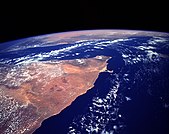A peninsula[1][2] is a landform that extends from a mainland and is surrounded by water on most sides.[3][4][5] Peninsulas exist on all continents.[6][2] The largest peninsula in the world is the Arabian Peninsula.[7][8]
Etymology
The word peninsula derives from Latin paeninsula, from paene 'almost', and insula 'island'. The word entered English in the 16th century.[3]
Definitions
A peninsula is generally defined as a piece of land surrounded on most sides by water.[5][9]
A peninsula may be bordered by more than one body of water, and the body of water does not have to be an ocean or a sea.[10] A piece of land on a very tight river bend or one between two rivers is sometimes said to form a peninsula, for example in the New Barbadoes Neck in New Jersey, United States.[5] A peninsula may be connected to the mainland via an isthmus, for example, in the Isthmus of Corinth which connects to the Peloponnese peninsula.[11]
Formation and types
Peninsulas can be formed from continental drift, glacial erosion, glacial meltwater, glacial deposition, marine sediment, marine transgressions, volcanoes, divergent boundaries or river sedimentation.[12] More than one factor may play into the formation of a peninsula. For example, in the case of Florida, continental drift, marine sediment, and marine transgressions were all contributing factors to its shape.[13]
Glaciers
In the case of formation from glaciers (e.g., the Antarctic Peninsula or Cape Cod), peninsulas can be created due to glacial erosion, meltwater or deposition.[14] If erosion formed the peninsula, softer and harder rocks were present, and since the glacier only erodes softer rock, it formed a basin.[14] This may create peninsulas, and occurred for example in the Keweenaw Peninsula.[14]
In the case of formation from meltwater, melting glaciers deposit sediment and form moraines, which act as dams for the meltwater.[14] This may create bodies of water that surround the land, forming peninsulas.[14]
If deposition formed the peninsula, the peninsula was composed of sedimentary rock, which was created from a large deposit of glacial drift.[15][16] The hill of drift becomes a peninsula if the hill formed near water but was still connected to the mainland, for example during the formation of Cape Cod about 23,000 years ago.[17][18]
Others
In the case of formation from volcanoes, when a volcano erupts magma near water, it may form a peninsula (e.g., the Alaskan Peninsula).[15] Peninsulas formed from volcanoes are especially common when the volcano erupts near shallow water.[19] Marine sediment may form peninsulas by the creation of limestone.[20] A rift peninsula may form as a result of a divergent boundary in plate tectonics (e.g. the Arabian Peninsula),[21][22] while a convergent boundary may also form peninsulas (e.g. Gibraltar or the Indian subcontinent).[23] Peninsulas can also form due to sedimentation in rivers. When a river carrying sediment flows into an ocean, the sediment is deposited, forming a delta peninsula.[24]
Marine transgressions (changes in sea level) may form peninsulas, but also may affect existing peninsulas. For example, the water level may change, which causes a peninsula to become an island during high water levels.[25] Similarly, wet weather causing higher water levels make peninsulas appear smaller, while dry weather make them appear larger.[26] Sea level rise from global warming will permanently reduce the size of some peninsulas over time.[27]
Uses
Peninsulas are noted for their use as shelter for humans and Neanderthals.[28] The landform is advantageous because it gives hunting access to both land and sea animals.[28]They can also serve as markers of a nation's borders.[29]
List of the largest peninsulas in the world
See also
References
Bibliography
- Heos, Bridget (2010). The creation of peninsulas (1st ed.). New York: Rosen Pub. ISBN 978-1-4358-5301-0. OCLC 277466133.
- Mis, Melody S. (2009). Exploring peninsulas (1st ed.). New York: PowerKids Press. ISBN 978-1-4358-2711-0. OCLC 230802567.
- Nadeau, Isaac (2006). Peninsulas (1st ed.). New York: Rosen Pub. Group's PowerKids Press. ISBN 1-4042-3125-0. OCLC 57068647.
- Niz, Ellen Sturm (2006). Peninsulas. Mankato, Minn.: Capstone Press. ISBN 0-7368-4308-6. OCLC 57366483.
- Word Histories and Mysteries: From Abracadabra to Zeus. Houghton Mifflin Harcourt. 2004. ISBN 978-0547350271. OCLC 55746553.
- Wyckoff, Jerome (1999). Reading the earth : landforms in the making. Mahwah, NJ: Adastra West, Inc. ISBN 0-9674075-0-8. OCLC 43274886.
External links
 The dictionary definition of peninsula at Wiktionary
The dictionary definition of peninsula at Wiktionary














































